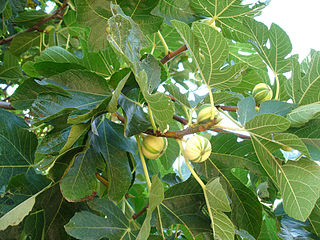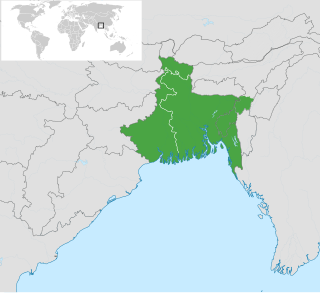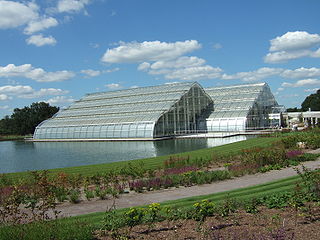
Variegation is the appearance of differently coloured zones in the leaves, and sometimes the stems, of plants. Variegated leaves occur rarely in nature. Species with variegated individuals are sometimes found in the understory of tropical rainforests, and this habitat is the source of a number of variegated house plants.

Cota tinctoria, the golden marguerite, yellow chamomile, or oxeye chamomile, is a species of perennial flowering plant in the sunflower family. Other common names include "dyer's chamomile", "Boston daisy", "Paris daisy". In horticulture this plant is still widely referred to by its synonym Anthemis tinctoria.

Dracaena reflexa is a tree native to Mozambique, Madagascar, Mauritius, and other nearby islands of the Indian Ocean. It is widely grown as an ornamental plant and houseplant, valued for its richly coloured, evergreen leaves, and thick, irregular stems.

Vinca major, with the common names bigleaf periwinkle, large periwinkle, greater periwinkle and blue periwinkle, is a species of flowering plant in the family Apocynaceae, native to the western Mediterranean. Growing to 25 cm (10 in) tall and spreading indefinitely, it is an evergreen perennial, frequently used in cultivation as groundcover.

Canna compacta Roscoe is a species of the Canna genus, belonging to the family Cannaceae, distributed between the south of Brazil and northern Argentina. Introduced to England from South America in 1820. Not to be confused with C. compacta Bouché, which is a synonym of C. indica L.
Canna 'Austria' is a medium sized Italian Group Canna cultivar with green foliage, oblong shaped, upright habit; oval stems, coloured green; flowers are cupped, self-coloured yellow, throat orange-red spots on yellow, staminodes are large; seed is sterile, pollen is low fertile; rhizomes are long and thin, coloured white; tillering is prolific. Introduced by C. Sprenger, Dammann & Co., Naples, Italy, EU in 1893.
Canna 'Phasion' is a medium sized Italian Group cultivar; green, bronze and pink variegated foliage, ovoid shaped, branching habit; oval stems, coloured red; clusters of flowers are open, tangerine-orange and burnt-red, staminodes are large, edges frilled, petals purple with farina, fully self-cleaning; seed is sterile, pollen is sterile; rhizomes are thick, up to 3 cm in diameter, coloured white and purple; tillering is average. Originally a spontaneous mutation, probably of Canna 'Wyoming', as it has been known to revert its foliage colour to that identical to that old cultivar. Sold in the US and elsewhere as Canna Tropicanna®, it was protected under US Plant Patent #10,569. Because the patent was issue on 1998-08-25, it has now expired and propagation is now allowed. The plant can be sold under its cultivar name Phasion.

Canna 'Florence Vaughan' is a medium Crozy Group canna cultivar; green foliage, oval shaped, branching habit; oval stems, coloured green; flowers are open, yellow with red spots, staminodes are medium size, edges regular, fully self-cleaning; fertile both ways, not self-pollinating or true to type, capsules globose; rhizomes are thick, up to 3 cm in diameter, coloured white; tillering is average. Introduced by A. Crozy, Lyon, France in 1892.
Canna 'Yellow King Humbert' Burbank is a medium sized Italian Group Canna cultivar; foliage green, but often variegated purple markings and occasionally whole leaves purple, oval shaped, spreading habit; oval stems, coloured green + purple; flower clusters are open, spotted, colours yellow with red spots, often large red markings and occasionally whole flowers red, staminodes are large; seed is sterile, pollen is sterile; rhizomes are long and thin, coloured white and purple; tillering is prolific.
Canna 'Pringle Bay' is a miniature Italian and variegated group canna cultivar; variegated foliage, oval shaped, spreading habit; flowers are open, self-coloured pink, staminodes are large; fertile both ways, not true to type, not self-pollinating; rhizomes are thick, up to 3 cm in diameter, coloured pink and purple. Its main attraction is the bright variegated foliage, green, bronze and pink. Only about 40 cm in height.

The Field Elm cultivar Ulmus minor 'Argenteo-Variegata' or simply 'Variegata', known in Australasia and North America as Silver Elm or Tartan Elm, is said to have been cultivated in France from 1772. Green noted that variegated forms of Field Elm "arise frequently, and several clones may have been known under this name". Dumont de Courset (1802) listed an U. campestris var. glabra variegata, Loudon (1838) an U. nitens var. variegata, and Wesmael (1863) an U. campestris var. nuda microphylla variegata.
Canna 'Musaefolia' cultivars belong to the Foliage Group of Cannas. In the first work devoted to Canna, Le Canna - authored by M. Chaté in 1867 with the co-operation of Monsieur Théodore Année, we were provided with the first written description and details of origin. The Musaefolia members of the Foliage Group consist of a specimen that was accepted as a native species of Peru by the experts of the time, and at least 7 hybrids and cultivars carrying that parentage. The original "species" was unique because it was without rhizomes, and required to be kept constantly growing. No such species is known to exist in this age, and leading authorities treat C. musaefolia as a synonym of C. paniculata.

Iris foetidissima, is a species of iris found in open woodland, hedgebanks and sea-cliffs.

Hakonechloa is a genus of bunchgrass in the Molinieae tribe of the Poaceae family (grasses), native to eastern Asia.

Dracaena fragrans, is a flowering plant species that is native throughout tropical Africa, from Sudan south to Mozambique, west to Côte d'Ivoire and southwest to Angola, growing in upland regions at 600–2,250 m (1,970–7,380 ft) altitude.

Pittosporum tobira is a species of flowering plant in the pittosporum family Pittosporaceae known by several common names, including Australian laurel, Japanese pittosporum, mock orange and Japanese cheesewood. It is native to Japan, China, and Korea, but it is used throughout the world as an ornamental plant in landscaping and as cut foliage.
Buddleja davidii 'Purple Prince' is an old American cultivar raised by Paul Schmidt at Youngstown, Ohio. The cultivar is believed to be the progeny of a crossing with 'Ile de France'. 'Purple Prince' came 3rd overall in the public popularity poll conducted by the Royal Horticultural Society in its Buddleja trials at Wisley from 2008 to 2010.

Buddleja × weyeriana 'Flight's Fancy' is a little-known British cultivar once marketed by Webb's of Wychbold, Worcestershire.




















